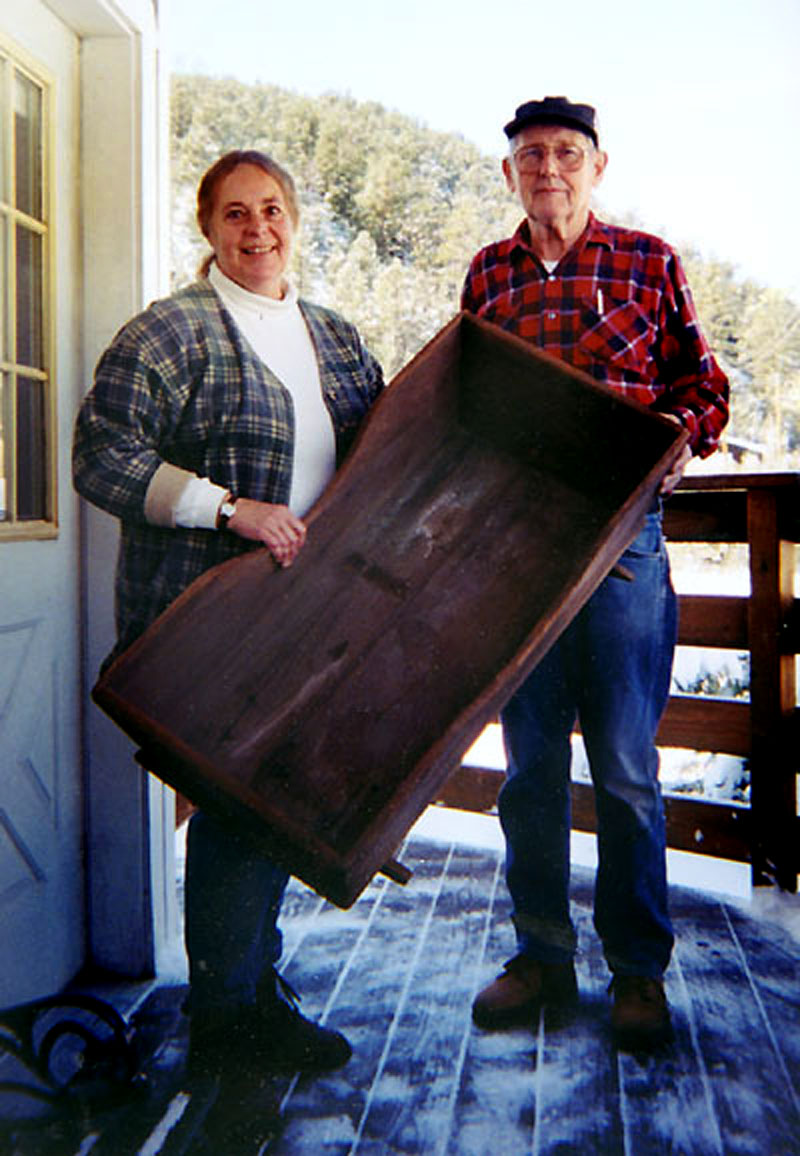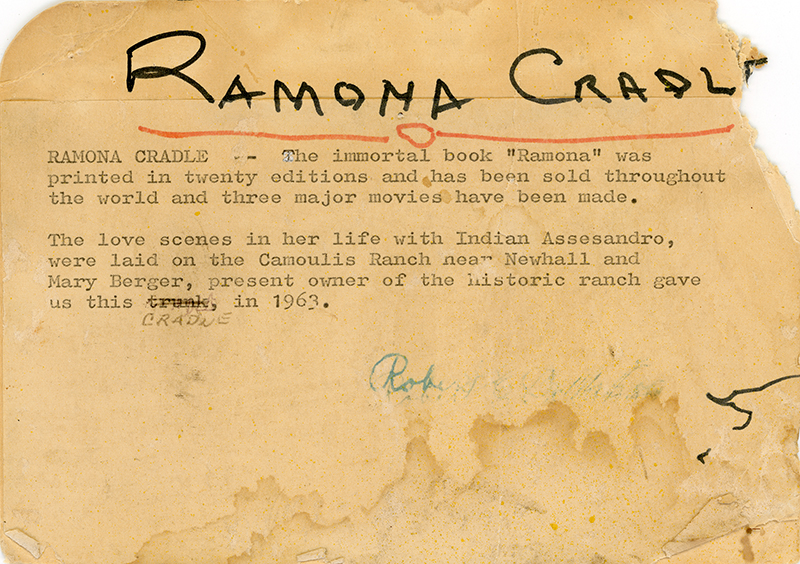|
|


January 27, 2001 — Curator Curtis Newman and Historian Bonnie C. Kane of the Ridge Route Communities Museum & Historical Society in Frazier Park show the Ramona Cradle as they transfer it to the Santa Clarita Valley Historical Society.
The "Ramona Cradle," as Robert E. Callahan called it, was donated in 1963 by Mary Berger, owner of Rancho Camulos, to Callahan's Mission Village in Culver City. The name derives from "Ramona," the 1884 novel by Helen Hunt Jackson that was loosely based on Jackson's visit two years earlier with the Del Valle family at Rancho Camulos in the western Santa Clarita Valley (near Piru). Callahan, an actor, author and pseudo-historian with an interest in Native Americans, moved his Mission Village tourist attraction in 1963 to Sierra Highway in Saugus-Agua Dulce, where he called it Callahan's Old West Trading Post. (The Mission Village property was needed for the Santa Monica Freeway.) Following Callahan's death, his widow, Marion (Kitty Kelley), donated the cradle — along with the Ramona Chapel, Red Schoolhouse and other items from Callahan's Old West — to the SCV Historical Society in 1987. After the death of the Society's first curator, Jerry Reynolds, in 1996, the cradle was missing — until January 2001, when historian Bonnie C. Kane of the Ridge Route Communities Museum & Historical Society realized it had found its way to Frazier Park, with certain other items. The Ridge Route museum's log book confirmed the cradle's identity as the one "from Rancho Camulos;" it and the other missing items were repatriated with the SCV Historical Society. Restored by Ridge Route Communities Museum curator Curtis Newman, the cradle is fabricated with square nails, placing its origin in the 19th Century. Descendants of Ygnacio del Valle owned Rancho Camulos until the 1920s, so the cradle probably belonged to the Del Valle family. Santa Clarita Valley Historical Society collection, courtesy of Marion Callahan — and the Ridge Route Communities Museum & Historical Society.
About Callahan's Old West. Robert E. Callahan's Old West Trading Post, aka Indian Village, at 13660 Sierra Highway in "Outlaw Canyon" was the equivalent of an amusement park of its day. Callahan (b. Oct. 27, 1892; d. Jan. 10, 1981), an entertainer and novelist, exploited America's fascination with all things Western — especially the romanticized notions of Old California as presented by Helen Hunt Jackson in her seminal 1884 novel, "Ramona" — by collecting objects with a connection, real or imagined, to the novelist and her work, and enticing the public to experience them. Callahan's initial visions of creating an amusement park to be called Ramona Village morphed into the Mission Village Auto Court, which he opened in 1926 at 5675 W. Washington Blvd. in Culver City. Along with a themed hotel, he erected teepees for travelers and put his collections on display, including a chapel, little red schoolhouse and kiva (a small sweat lodge). Auto parks were big business as the automobile came into age in the 1920s. There were a few auto parks in the Santa Clarita Valley, most notably McIntyre's camp at Castaic Junction, which was wiped out in the 1928 St. Francis Dam disaster. In time, L.A. city builders had a different vision for Callahan's Culver City property. By the early 1960s, Mission Village stood in the way of the coming I-10 Santa Monica Freeway. So in 1962 Callahan closed Mission Village and moved it to 13660 Sierra Highway. (The freeway was completed in 1965). Note: In Callahan's day, that part of Sierra Highway was known as Saugus. The county of Los Angeles later included it within the Acton-Agua Dulce Town Council's sphere of influence. It is commonly considered part of Agua Dulce today. In 1987, Callahan's widow, Marion, donated several artifacts from the former Indian Village — including the Ramona Chapel and little red schoolhouse — to the Santa Clarita Valley Historical Society. The main building remained on the property, and from From 1986-2000, Marion Callahan leased it to the Canyon Theatre Guild. In 2000 the CTG moved back to downtown Newhall where the community theatre had started.
rc8701b: Digital image by Leon Worden, January 27, 2001.
|
Pollack Story
Callahan & Carrie Jacobs Bond in Ramona Chapel 1927
Ramona Cottage ~1930s
~1940s
Callahan with Hopi Indians Employees
Good Luck Charm
'Hopi Snake Dance' Booklet
Description 1965
1967 Visit x3
Tom Shubert Story
Ray Saniger Performs 1967/70 (Mult.)
Summer of 1967
1972 Horror Film
Outlaw Saloon
Hopi Shrine
Red Schoolhouse
Ramona Chapel
Main Building
Good Luck Charm
Wrong Address
Good Luck Charm
Correct Address
$1,000 Las Vegas Loot
Schoolhouse Origin
The Callahan Collection: Donation Records
Schoolhouse Arrives 1987
Ramona Cradle x2
|
The site owner makes no assertions as to ownership of any original copyrights to digitized images. However, these images are intended for Personal or Research use only. Any other kind of use, including but not limited to commercial or scholarly publication in any medium or format, public exhibition, or use online or in a web site, may be subject to additional restrictions including but not limited to the copyrights held by parties other than the site owner. USERS ARE SOLELY RESPONSIBLE for determining the existence of such rights and for obtaining any permissions and/or paying associated fees necessary for the proposed use.


























